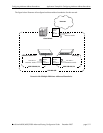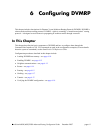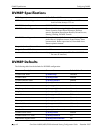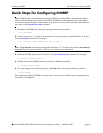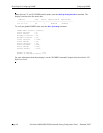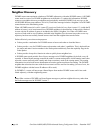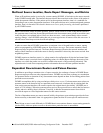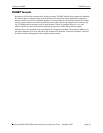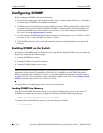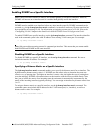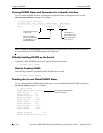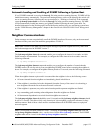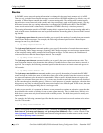
Configuring DVMRP DVMRP Overview
OmniSwitch 6800/6850/9000 Advanced Routing Configuration Guide December 2007 page 6-7
Multicast Source Location, Route Report Messages, and Metrics
When an IP multicast packet is received by a router running DVMRP, it first looks up the source network
in the DVMRP routing table. The interface that provides the best route back to the source of the packet is
called the upstream interface. If the packet arrived on that upstream interface, then it is a candidate for
forwarding to one or more downstream interfaces. If the packet did not arrive on that anticipated upstream
interface, then it is discarded. This check is known as a reverse path forwarding check and is performed
by all DVMRP routers.
Note. Under normal, stable DVMRP operation, packets would not arrive on the wrong interface because
the upstream router would not forward the packet unless the downstream router poison-reversed the route
in the first place (as explained below). However, there are cases—such as immediately after a network
topology change—when DVMRP routing has not yet converged across all routers where this can occur. It
can also occur when loops exist in the network topology.
In order to ensure that all DVMRP routers have a consistent view of the path back to a source, routing
tables are propagated by all DVMRP routers in Route Report messages. Each router transmits a Route
Report message at specified intervals. The Route Report message advertises the network numbers and
masks of those interfaces to which the router is directly connected. It also relays the routes received from
neighboring routers.
DVMRP requires an interface metric (i.e., a hop count) to be configured on all physical and tunnel inter-
faces. When a route is received from a neighboring router via a Route Report message, the metric of the
interface over which the packet was received is added to the metric of the route being advertised. This
adjusted metric is used when comparing metrics to determine the most efficient upstream interface.
Dependent Downstream Routers and Poison Reverse
In addition to providing a consistent view of source networks, the exchange of routes in DVMRP Route
Report messages provides one other important feature. DVMRP uses the route exchange as a mechanism
for upstream routers to determine if any downstream routers depend on them for forwarding packets from
particular source networks.
DVMRP accomplishes this by using a technique called poison reverse. If a downstream router selects an
upstream router as the best next hop to a particular source network, it indicates this by echoing back the
route on the upstream interface with a metric equal to the original metric plus infinity. (DVMRP uses a
metric of 32 as infinity.) When the upstream router receives the report and sees a metric that lies between
infinity and twice infinity (that is, between 32 and 64), it adds the downstream router from which it
received the report to a list of dependent routers for this source network.
The list of dependent routers per source network built by the poison reverse technique provides the foun-
dation necessary to determine when it is appropriate to prune back the IP source-specific multicast trees.
Note. Poison reverse is used differently in DVMRP than in most unicast distance vector routing protocols
(such as RIP), which use poison reverse to advertise that a particular route is unreachable.



